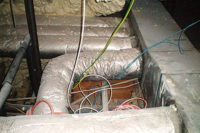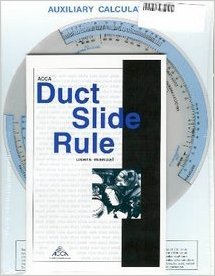In a previous column, I discussed some tough lessons I learned from measuring airflow with an air-balancing hood. From those lessons came an opportunity to offer a unique product that totally separated us from the competition. That product was an airflow upgrade — the process of surgically renovating and correcting duct-system defects through testing.
It’s a well-recognized fact that ducted HVAC equipment efficiency and performance are directly connected to the duct system. Through studies conducted by the National Comfort Institute (NCI), we have learned the average airflow from the typical system is found to be more than 30 percent less than most manufacturer’s recommended specifications.
With duct systems gaining more public attention than ever before, why not capitalize on this growing opportunity? Let’s take a look at airflow upgrades and how they might fit into your company.
WHAT IS AN AIRFLOW UPGRADE?
An airflow upgrade is a customized product that solves customers’ unique comfort and efficiency problems. Knowledgeable HVAC contractors are the only entities that can discover and provide this specialized product with proper training and test instruments. And, yes, an air-balancing hood is a primary weapon for finding and delivering airflow upgrades.
One of the worst assumptions made about an airflow upgrade is that the existing duct system must be completely demolished and then replaced. This simply isn’t the case. Parts of the duct system that work correctly may be left intact. Parts of the duct system that don’t work correctly are repaired. This is why an air-balancing hood is so essential; ducts that aren’t working correctly can’t be properly located without it.
Upgrading a duct system typically includes, but is not limited to:
• Adding a return duct to the main area of the home;
• Increasing the size of two or three branch runs to uncomfortable rooms;
• Adding dampers to branch runs with high airflow;
• Sealing duct leaks;
• Reducing filter pressure drop; and
• Changing out restrictive fittings and plenums.
Without the proper test data, it’s impossible to determine what’s really necessary. If you guess at the airflow upgrade that’s needed, you’ll be very disappointed with the results.
DISCOVERING AIRFLOW UPGRADES
Airflow upgrades aren’t something you discover with a visual inspection alone. They’re discovered through testing and asking customers smart questions. This establishes the scope of work needed to assure a successful airflow upgrade.
Remember, each airflow upgrade is unique to the needs of the customer and his or her HVAC system. Just as an individual wouldn’t feel comfortable with a doctor recommending open-heart surgery based off his or her physical appearance, airflow upgrades are the same way. Tests must be performed to establish a baseline and identify weak points in the duct system that will need to be addressed.
Technicians use total external static pressure as one of the first tests to determine the need for an airflow upgrade. This test is the foundation for how much duct repair needs to be done. If static pressure is excessive, equipment can’t move the needed airflow and duct size will likely need to be increased. If static pressure is acceptable, the airflow upgrade may not be as extensive.
The static pressure drop taken over certain components of the system can also be used to identify areas of airflow restriction in the duct system that need repair. A restrictive coil, air filter, or duct fitting can quickly be discovered through these tests and explained to the customer.
Consistent testing during service and maintenance calls allows a tech to discover additional opportunities to offer airflow upgrades. These discoveries are made using static pressure readings and fan airflow measurements. Think about how a doctor records weight, blood pressure, and temperature at each office visit — this is the consistency I’m referencing.
Another source for discovering airflow upgrades is customer complaints, such as concerns over uncomfortable rooms, large temperature swings, high utility bills, and repeat repairs. Armed with an air-balancing hood, a salesperson can measure register and grille airflow to help the customer discover the source of these complaints.
DISCUSSING AIRFLOW UPGRADES WITH CUSTOMERS
When discussing airflow upgrades with a customer, keep it simple and focused on how it will solve his or her problems. If a tech begins discussing air density or uses industry abbreviations, he or she’s going to confuse the homeowner. Don’t talk in an unknown language or get too technical.
Use basic principles that relate to the problems at hand. Relating high total external static pressure to high blood pressure and low fan airflow to failing report card grades are comparisons frequently used to help a customer understand the poor operating condition of the system.
EACH UPGRADE IS UNIQUE
Based on a customer’s needs, budget, and testing results, a tech will define an airflow upgrade plan that fits each unique situation. Not everyone wants the same thing, and very few will be willing to pay for perfection.
Getting past the perfection hang-up can be a big challenge for those who measure performance. Unless the customer yearns for perfection and is willing to invest in it, a tech may hinder his or her success by pursuing it. Keep the attention focused on their problems and what it will take to solve it.
By focusing on a customer’s problems, the tech is allowed to create a unique product that competitors are unable to duplicate.
VERIFYING AIRFLOW UPGRADE SUCCESS
Before any work is done, a tech will need to test-in to establish a baseline of how the system is operating. Once the airflow upgrade is complete, he or she will need to test-out to ensure the upgrades are achieving the desired results.
Don’t make the mistake of assuming a tech’s designs will automatically work. Remember one of the lessons I learned from a balancing hood: Our duct designs often didn’t do what we intended. The only way we discovered this was through airflow measurement.
The rubber meets the road when airflow upgrades are tested to assure they operate as intended.
CUSTOM CONTENT PROVIDER
Everyone in the company wins when a contractor elects to add airflow upgrades to its arsenal. Installers stop making many of the common mistakes that kill airflow and system performance. Technicians look past the equipment and account for the impact of the entire system when troubleshooting. Salespeople find new opportunities to correct long-standing issues the competition can’t address. Owners differentiate their companies and increase sales by becoming a custom provider of comfort and efficiency solutions.
Airflow upgrades are an essential step in helping the industry get back to the craftsmanship that make it great. A tech’s imagination is the only limit to the results that can be achieved. Why not take advantage of the huge level of inventory available instead of becoming disheartened by being beaten on a bid? Change the game and offer a product the competition unknowingly creates for your HVAC company daily.
Publication date: 4/4/2016
Want more HVAC industry news and information? Join The NEWS on Facebook, Twitter, and LinkedIn today!











